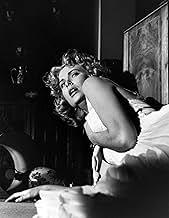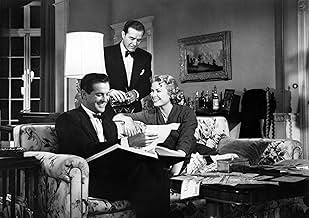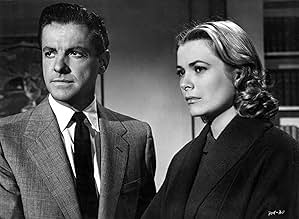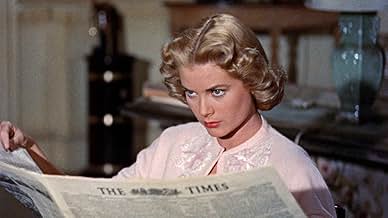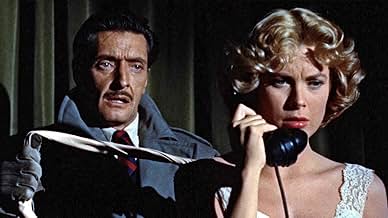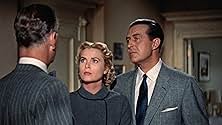Un ex tennista decide di uccidere sua moglie per ereditare i suoi soldi e vendicarsi di un caso che aveva avuto. Per sbarazzarsi del senso di colpa, usa un vecchio collega del college. Ma le... Leggi tuttoUn ex tennista decide di uccidere sua moglie per ereditare i suoi soldi e vendicarsi di un caso che aveva avuto. Per sbarazzarsi del senso di colpa, usa un vecchio collega del college. Ma le cose non andranno come previsto.Un ex tennista decide di uccidere sua moglie per ereditare i suoi soldi e vendicarsi di un caso che aveva avuto. Per sbarazzarsi del senso di colpa, usa un vecchio collega del college. Ma le cose non andranno come previsto.
- Nominato ai 1 BAFTA Award
- 5 vittorie e 3 candidature totali
- Banquet Member
- (non citato nei titoli originali)
- Detective
- (non citato nei titoli originali)
- Bobby Outside Flat
- (non citato nei titoli originali)
- Police Photographer
- (non citato nei titoli originali)
- Detective
- (non citato nei titoli originali)
- Woman Departing Ship
- (non citato nei titoli originali)
- Banquet Member
- (non citato nei titoli originali)
- Banquet Member
- (non citato nei titoli originali)
Riepilogo
Recensioni in evidenza
However. it actually has a lot going for it, being beautifully shot in luminous colour, extremely well acted in almost every role and peppered throughout with those eye-catching and brain-satisfying flourishes which so distinguished the director from the rest.
Yes, it is very set-bound, betraying its stage origins and likewise very talky, especially on exposition, but it keeps the viewer alert throughout and delivers a neatly satisfying conclusion. I do wish Hitchcock could have done better with his back-projection unit (an old-fashioned, jarring trait he still hadn't grown out of by "Marnie" some 10 years later) and I occasionally found the constant too frivolous background music an intrusion, but it's well paced throughout, helped considerably by an on-form cast.
Ray Milland is excellent in a kind of darker Cary Grant type persona, Grace Kelly (who'd want to murder her?) goes convincingly from loveliness to wretchedness while it's pleasing to see Robert Cumming to the fore, recalled by Hitch for the first time in over a decade (since "Saboteur" in 1942). The actors playing the would be murderer and nosey police inspector are just fine too.
About those flourishes..., perhaps the most famous being the changing spotlight on Grace Kelly's doomed face as her trial is condensed into just a few terse minutes and of course the murder scene itself, even if one can't imagine her extended stabbing gesture being strong enough to cut through Swann's jacket far less kill him stone dead, but I also enjoyed the raised tracking shot looking down on Milland as he explains his plot to Swann and particularly the parting shadows of lovers Cumming and Kelly at Milland's unexpected approach.
Yes, it's old fashioned Hollywood movie-making, but it's old-fashioned Hollywood movie-making at its best and in my opinion an unjustly overlooked effort from the Master.
Dial M for Murder succeeds on many levels, and it is largely thanks to some superb dialogue, written from a tricksy-yet-capable script that never gets too deep. The cast are a treat. Ray Milland is an absolute gem, extremely sly and dispassionate, yet a character so full of self-assurance that one almost sides with him. Grace Kelly completes her great year (she gave an Oscar-winning performance in The Country Girl and also starred in Rear Window) by emanating the poised, beautiful being, that is vulnerable, yet oddly unassailable. And it's weird in that even though she's cheating on her husband, you care for her a lot more than him (although that could do with the fact that he's trying to kill her...) And John Williams, as the police detective, is quite wonderful.
Alfred Hitchcock manipulates and enthrals his audience here like the master that he is. Each scene has a sense of direction, great pacing, and is staged realistically. Stunning full colour photography and a haunting, atmospheric score from Dimitri Tiomkin complete this great package. The ending, when it comes, feels a little too nice to be truly realistic, but that is my only major quibble with an otherwise highly entertaining, thrilling movie.
Hands down the father of noir-film.
I'm working my way through Hitchcock's tremendous catalogue of films, I've kept this one til the end purposely, as I regard it as one of his best. It's suspenseful, it's intriguing, but best if all, it's clever.
Dial M for Murder has a genius plot, it is so clever, the plot is intricate and complicated, it never fails to impress me, so many details, and a spider's web that few could imagine.
I've been lucky enough to see this on stage a few times, it lends itself very well to The Theatre, this is one film I'd love to see retold.
I'm glad Ray Milland was cast as Tony, he's perfect in the role, he's charming and respectable, but has a wolfish like quality, the kind of guy that would shake your hand, then give you a black eye later on. Grace Kelly and Robert Cummings are terrific.
It's been adapted a few times, one version I quite enjoyed is a Perfect Murder, featuring Michael Douglas, it's not a patch on this, but it's very good.
I love that there's an intermission in it, it's a shame the third Lord of The Rings film didn't follow suit.
9/10.
But the dialogue, put on film here, is exceptional. I write this review having seen "Dial M for Murder" two or three times and wanting to see it once again. Many reviewers, myself included, have tried watching films with the sound off. I want to try the opposite. I want to close my eyes and just listen to the dialogue because it's so strong. The MacGuffin conversation at the beginning, with a perfectly cast Ray Milland blackmailing a perfectly cast Anthony Dawson into murdering a perfectly cast Grace Kelly is brilliantly written by Mr. Knott. It was clearly from a stage production, as it explains the plot background in great detail, and goes on for the better part of twenty minutes. Both men are fleshed out, giving us their personalities and individual tendencies. And even though "Dial M for Murder" pretty much stays on just one small set (an apartment in London, in which we see mostly the foyer, a little of the bedroom, and just a glimpse of the kitchen), what happens there is so fascinating that we do not really want to venture out into the city.
And that is just the setup. The dialogue remains insistently interesting and clever throughout the picture. It also has that subtle, dark sense of humor that Alfred Hitchcock was keen on. It also has the ironic touches, such as when Mr. Milland, as the jealous husband, kisses his unfaithful wife on the night she is to be murdered, and tells her: "Goodbye, my dear." The audience, having been given every single little detail about the scheme and how it is to unfold, cringes with a dark realization that Mr. Hitchcock might just go through with Mr. Milland's plot. Mr. Hitchcock, as the director, is also due tremendous credit for his trademark of creating tension. Screenwriter Knott brilliantly lays out for the audience, not the victim, how the murder will go through, but Mr. Hitchcock's camera dutifully follows everything as the scheme goes along. And, before we realize it, if something starts to go wrong, we become scared and tense. And you can imagine my guilt when I realized I was feeling scared that a plan to murder someone just might not go through. It's Mr. Hitchcock's gift at work.
Dimitri Tiomkin, a very good film composer, hits all the write notes; that includes knowing when he needs to tell his violins and trumpets to shut up. Robert Burks' cinematography is also strong with effective usage of shadows and streaks of light. Colors are omnipresent. And even though "Dial M for Murder" was shot with the intent to be seen in 3D, it is hardly evident. When I first saw the film, in much superior 2D, I did not mind the lamps and such in the foreground, such as when one bisects the screen between Ray Milland and Anthony Dawson during the opening sequence. I just thought it was a clever piece of filmmaking and misc en scene, not a cheap gimmick like in most 3D movies today. "Dial M for Murder" is a near-perfect movie of its kind, pumped full of smart dialogue and dazzling energy. This is one of the few play-to-movie transition that I have seen where I have suddenly become eager to see the original stage production.
Lo sapevi?
- QuizAlfred Hitchcock wanted Cary Grant to star, but Warner Brothers felt that he would be miscast as a villain.
- BlooperWendice throws a £100 bundle on a pink armchair. The money falls right at the back of the seat. A few minutes later, Swann takes the money which is now right in front of the armchair.
- Citazioni
Tony Wendice: How do you go about writing a detective story?
Mark Halliday: Well, you forget detection and concentrate on crime. Crime's the thing. And then you imagine you're going to steal something or murder somebody.
Tony Wendice: Oh, is that how you do it? It's interesting.
Mark Halliday: Yes, I usually put myself in the criminal's shoes and then I keep asking myself, uh, what do I do next?
Margot Mary Wendice: Do you really believe in the perfect murder?
Mark Halliday: Mmm, yes, absolutely. On paper, that is. And I think I could, uh, plan one better than most people; but I doubt if I could carry it out.
Tony Wendice: Oh? Why not?
Mark Halliday: Well, because in stories things usually turn out the way the author wants them to; and in real life they don't... always.
Tony Wendice: Hmm.
Mark Halliday: No, I'm afraid my murders would be something like my bridge: I'd make some stupid mistake and never realize it until I found everybody was looking at me.
- Curiosità sui creditiThe title is shown on a background of a British telephone dial; its MNO marking is replaced by a single large M which forms the single M of the title.
- Versioni alternativeThe film had an intermission in its original 3-D release, although it is less than two hours in length.
- ConnessioniEdited into Histoire(s) du cinéma: Le contrôle de l'univers (1999)
I più visti
Dettagli
- Data di uscita
- Paese di origine
- Lingua
- Celebre anche come
- Con M de Muerte
- Luoghi delle riprese
- Azienda produttrice
- Vedi altri crediti dell’azienda su IMDbPro
Botteghino
- Budget
- 1.400.000 USD (previsto)
- Lordo Stati Uniti e Canada
- 24.845 USD
- Fine settimana di apertura Stati Uniti e Canada
- 12.562 USD
- 11 apr 1999
- Lordo in tutto il mondo
- 45.313 USD
- Tempo di esecuzione1 ora 45 minuti
- Colore
- Proporzioni
- 1.66 : 1
Contribuisci a questa pagina




